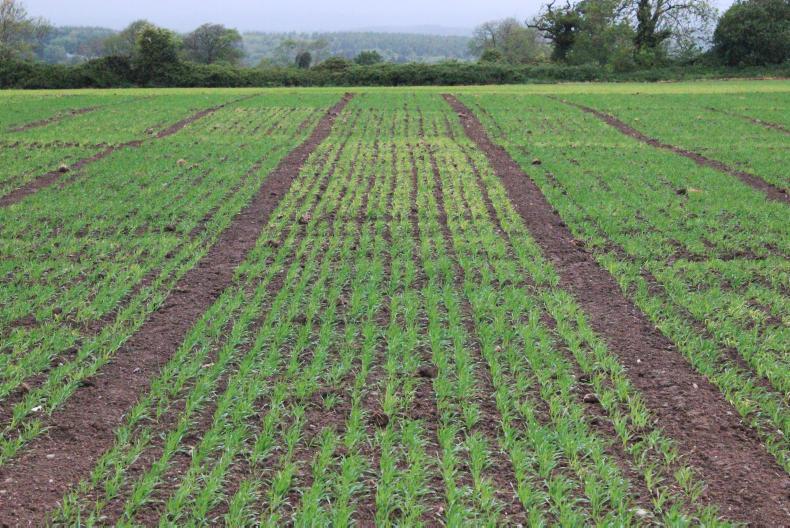Potassium (K) is a nutrient that generally does not get due respect and this can be easily seen in places this spring. Last weekend, I received an email from Teagasc’s Mark Plunket to tell me about a trial they have in field outside Arklow and I visited this earlier this week with local adviser Martin Bourke.
My first thought entering the field was that I had never seen this before, but then I remembered I had. But if I had not been told what the problem was, I might well have suggested salt damage from the sea or possible drift from a nearby Gramoxone application. But the effect was not uniform. Martin explained.
The field had been in two crops in recent years. One half grew maize last year and the other had been in grass silage for the past four years. This year, it is all in spring barley.
Aware of the possible consequences of continuous silage on soil K levels, Martin had taken two separate soil samples, which revealed K levels of 17mg/l or Index 1 following the silage and 55mg/l or Index 2 following the maize which received slurry.
The decision was then made to put in a trial on each side of the field which looked at application rates of 0kg, 40kg, 80kg, 120kg, 160kg and 200kg K/ha. These amounts were applied as muriate of potash (MOP), sulphate of potash (SOP) and muriate plus kieserite to supply the same amount of sulphur as the SOP.
Most treatments were incorporated into the seedbed prior to planting, but some were applied post-planting. And a few additional muriate plots were included, which are to be sprayed with foliar K later in the season.
The crop sown was Planet spring barley. It was sown around the middle of April and the area under the trials received up to 60kg P/ha to ensure that this was not a limiting nutrient.
The appearance of the crop on the Index 1 site would certainly suggest that the lack of potash must have severely limited grass yield also in recent years.
Index matters
There were a number of clear observations that could be made from the site. Firstly, the Index 1 and Index 2 sites were chalk and cheese. Except for little bits of natural variability at the Index 2 site, there was very little obvious difference between the treatments.
However, the 0kg K plots were visible in some replications. Martin told me that there had been substantial visual difference apparent prior to the recent rain, but that this appears to have kicked on all treatments equally, for the moment at least.
While all treatments looked good on the Index 2 site, it remains to be seen if there will be enough K to support high yield on many of the treatments when the big demand comes later in the season as crop bulk increases.
There was evidence of deficiency symptoms last week, but these had been mainly masked by recent growth. Martin did say that the treatments which received the K on top post-planting were quite visible up to this week.
Index 1
Deficiency symptoms were visible in virtually every treatment in the Index 1 trial following the continuous silage. But there were differences. The more K that was applied, the better these plots looked.
Martin said that these plots also looked much better this week than last, following the rain, but deficiency symptom were still very visible. The 0kg K plots were totally yellow and the small leaves frequently lay on the ground. Many plants had parts of the leaf dead.
As a general comment, MOP treatments looked better than SOP treatments or at least they seemed to be recovering quicker. There were visibly more plants showing deficiency symptoms once the K application rate dropped below 160kg K/ha. All treatments which received K post-planting looked little better than the control, but they are improving now. The use of kieserite with the MOP appeared to show greener foliage, especially on the Index 1 site.






 This is a subscriber-only article
This is a subscriber-only article














SHARING OPTIONS: